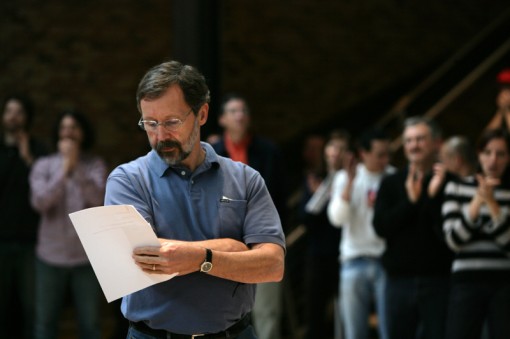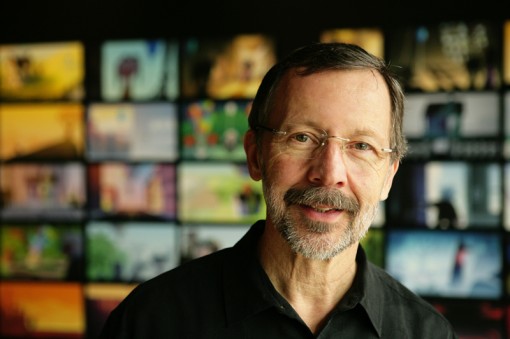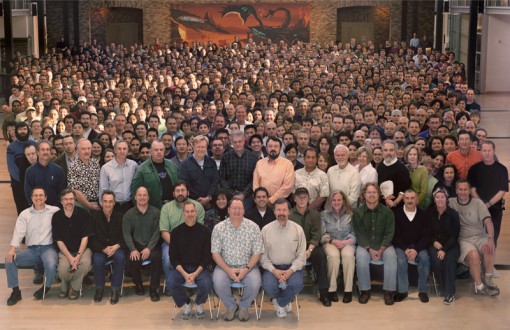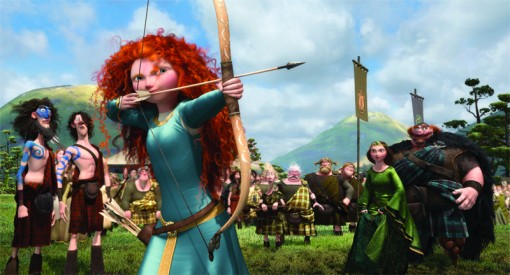There are a handful of people in this world who represent everything that the CG animation community has been able to achieve in the past few decades. Pixar co-founder and president Dr. Ed Catmull, who is also the president of Disney Studios, is one of the top visionaries in our field who has played a huge role in expanding the role of computer animation in our daily lives and building a company that has set sky-high standards in what our favorite art form can deliver. We were lucky to chat with this five-time Oscar winner about his vision for his studio, leadership philosophies and where he would like to see animation take us in the next decade:
Animag: We’re sure the first question everyone asks you is, how are you able to find enough hours in a day to run both Disney and Pixar studios?
Ed Catmull: Well, I have a young child at home, so I don’t have a lot of speaking engagements. John Lasseter and I go back and forth a lot, and what we set out to do is to make sure the studios are quite distinct from each other. We don’t want them to merge; that would definitely be the wrong approach. Each should have its own personality. Each one of them (DisneyToon Studios, Pixar, Disney Animation) have their own general managers and they all do a fantastic job.
What was important for us was to make sure that the directors have a supportive community. They have their own strengths and they own each other’s successes. I would say that’s the key to making it work. They all help solve the problems. Basically, we have filmmakers giving notes to filmmakers. Philosophically, the director—whether they’re at Disney or at Pixar—should have the final word on their movie.
Animag: In the past, you have talked about your approach to management and how the peer-driven review sessions are largely responsible for having a positive creative environment at the studios. Can you elaborate on that for us?
Catmull: Sure, that approach is important because what happens is that you don’t have people worrying about their projects getting killed or screwing up. By having the right kind of relationship, the giving of the notes and taking of the notes are focused on the film and not some other agenda. We kept the studios separate. You see, every film gets in trouble at some point. When the film gets in trouble, they reach out for help. I remember when we were first acquired by Disney, Ratatouille got into trouble, and Bolt got into trouble. We had three people at the other studio who could have helped out, but we said no, you can’t help the other studio. We drew a hard line. The consequence was that when Disney made Bolt, nobody bailed them out. When Ratatouille got into trouble, nobody got them bailed. We want to have a culture where there’s a strong local ownership to the films that are made.

Animag: When looking back at this past quarter of a century, did you ever imagine that placing polygon vertices through a model of your hand could lead to movies as complex and breath-taking as Toy Story 3 and Brave?
Catmull: It’s interesting that your magazine is also 25, the same age as Pixar! Frankly when we started, it was just barely within conception that we could do a film at all. And even when the film first came out, the thought was that was lucky and good, and we had great people working on it, but you can’t do it again. Everyone knows that sooner or later you’re going to screw up! All this time, you think that you’re going to screw up on the next film. I would have never guessed that we would go through 12 successful films in a row. What people don’t realize is that the danger of making a mistake is just as real in every single film. You can never think that you’ve figured it all out.
Animag: What about the future? What is your gut instinct about where CG animation and technologies are going to take us in the next 25 years?
Catmull: There’s one thing that people don’t understand about technology: They recognize that technology has fundamentally changed everything and because of that, there are questions about what technology is going to be like in a few years from now. But if you step back, and consider what happened when Walt Disney was starting his company, you realise that at that time, the technology of filmmaking and animation was brand new. At that time, it was high technology and it was pretty magical. Every time they were inventing something new. You had color, sound, blue-screen matting, multiple-plane cameras, gyrography—all these things were brought in and absorbed and driven by the studio, so the technological change was an integral part of the mind set.
Years later, you don’t look at the mindset! What you do remember, is what you saw at Epcot Center and the parks and so forth, but they represented a way of thinking. Technology was part of a mindset. After Disney died, they went through this notion that we should quit changing so much, let’s just focus on the art. I’m of the belief that changing the tool is an integral part of the mindset. Artists and technologists are of the same mindset. We have world-class technical people and world-class artists here…You compare the two…and they are similar. The bell curve of the minds of the artists and technical people look the same. They may be brilliant in different domains, but you shouldn’t put them in separate boxes. That’s one of our foundations here.
Going back to your question about the future, I’ve never predicted the future, not even technically, because things keep changing. You want to create an environment where it’s safe and you can change. I don’t know what the future is, but I do know that you have a lot of smart people here, and you want to keep them free to let them create something that’s unpredictable. In the movie business, there are a lot of movies that are predictable, but we enjoy the ones that give us something unexpected. So how do you come up with films that are unexpected? The best you can do is to say, “I’m going to let it happen, I don’t know what it is.” Look at Ratatouille, WALL•E and Up. We started with notions that don’t automatically make sense—you make a movie about a rat that wants to cook in a kitchen, or a trash compacter that falls in love, or the friendship between an old man and a little cub scout. What you want to do is create an environment where you can protect the unlikely.

Animag: Can you talk a little bit about the art of bringing artistic and technical people together to make the most of their talents?
Catmull: At a cultural level, they each have to believe that the other is the best in the world. We use the films themselves as our underlying principle: It’s not whether the technology or the art needs to be good, but the movie needs to be good. Everything else is secondary to that. That is the shared value that everyone has, and as long as everybody has the same shared value, and they just look at the fact that they are contributing to make it happen, from that you get a situation that they get together to solve a problem. It’s not a point of conflict when it’s about working with each other and helping each other. You simply just make sure you have your values correct, which is a very clear notion about making honest films with integrity and emotion.
Animag: What is your take on the overall state of animation around the world?
Catmull: There are two or three things that are happening simultaneously—part of it is because of the Disney renaissance of the early 1990s. More schools began to train people. We have a higher number of places where students can get high-quality training worldwide. So the base of artists is getting larger. Along with that, the technical tools are getting better and cheaper. Schools are able to put together shorts and new works coming out of research departments. More studios are jumping into the field because they can afford the tools and more people are trained, so the result is this golden age where there’s a lot of material. Some are just jumping in just because they think it’s the thing to do. Sure, there’s some poor animation, but there is also a lot of good stuff here. And they represent differences in viewpoints which is healthy for the industry and we all want a healthy film industry. For us to produce successful, healthy films is good for everybody.

Animag: Does the fact that Pixar has had 12 hits in a row create some angst and pressure as well, to maintain that pristine record?
Catmull: We try to be careful with the directors and not put too much pressure on them. But regardless of what we tell them, they don’t want to be the one to lose that record themselves. There’s a lot of self-imposed pressure, but that’s why you need to have everyone helping each other out. If things don’t work out, we do things internally. But while people may think this is a smooth-running machine, it’s not. It’s just as hard as anywhere else. The only difference is that if we don’t like it, we don’t release it!
Animag: What would you say is the toughest part of your job?
Catmull: It’s kind of hard to answer, because of the morale at Disney after Tangled was a big success, Wreck-it-Ralph is going to be great. The DisneyToon Studios’ Fairies series is also doing very well, so the morale is great, they have a new building in Glendale which is really nice. And we have some really cool projects coming up at Pixar. I am actually feeling very happy, and the general managers at each of the studios are pretty good, and they all get along very well with each other. All this attention to culture and how people work with each other pays off! So it makes it all a labor of love.

Animag: What do you love best about your job?
Catmull: This is ironic, not people may expect this. But when we have problems, which we always do, it’s great when people feel like they own the problem. They don’t say to the managers, “Oh what are you gonna do to fix the problem?” What they’re saying is: “We’ve got a problem, what can we do?” That makes me feel better than anything else. That’s real ownership. Everyone wants to own a success—but when they feel like they own the problems, that’s when you really own a studio!
Animag: What kind of advice do you give people who want to get ahead in this field?
Catmull: I am going to give an answer that might seem contradictory. One is that I believe that people should have breadth…that’s what I like about general education, history, economics, thought, etc. The second thing is I believe that each person, when they go to college, they should pick one area that they’ll get into very deep. To experience a deep understanding of one thing…to master something helps you get the confidence to master something else. One level is a horizontal one and the other is vertical, very deep.

Animag: What were some of the movies/TV shows that made a big impact on you when you were growing up?
Catmull: From the animation world, there were two films that really grabbed me as a child. One was Pinocchio and the other was Peter Pan. The interesting thing was that I was heavily influenced by those two films when I was a young boy. But it was years later when I saw them again as an adult, that I realized that I had remembered things in the movies that in fact were never in them. The movies were so evocative to me as a child that I had filled in that world. That’s what children do, they fill in the gaps with their imagination. Of course, seeing Walt Disney on TV was a huge inspiration. As I got older, my favorite live-action movies were more dramatic, films like Who’s Afraid of Virginia Woolf?, Patton, Amadeus and Sleuth.
Animag: Do you watch anything on TV regularly these days?
Catmull: Given my schedule, the only thing that I watch on a regular basis is American Idol. It’s kind of funny… There are things I love about it. It goes through three different stages, where you actually see young people change as they go through the changes.
I know it’s changed because it’s no longer Paula and Simon, but it was this great metaphor with the judges: one of them represented your mother and the other was cold, hard reality. The fact is that there are times when we want our mother and there are times when we have to face cold, hard reality. There’s something I’ve always loved about that metaphor.
Disney/Pixar’s next big release is Brave, directed by Mark Andrews and Brenda Chapman, which opens in U.S. theaters on June 22 and continues its global rollout through August.




 Win a Funko X Lilo & Stitch Prize Pack!
Win a Funko X Lilo & Stitch Prize Pack! 
